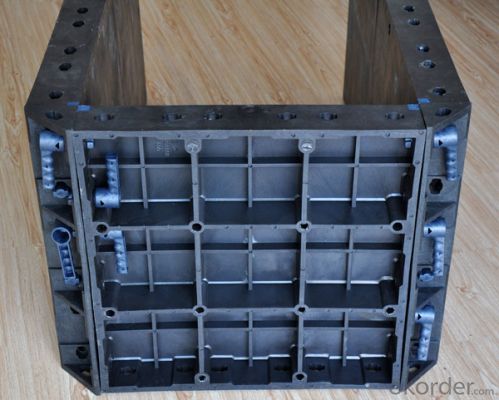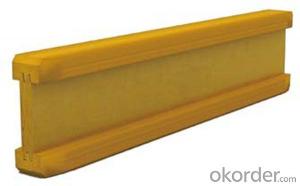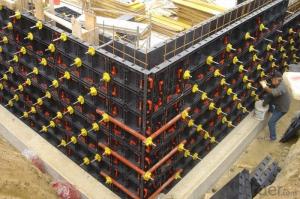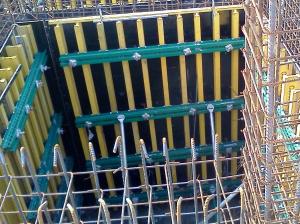Circular Column Formwork Outrigger for Scaffolding
- Loading Port:
- Tianjin
- Payment Terms:
- TT OR LC
- Min Order Qty:
- 5000 set
- Supply Capability:
- 50000 set/month
OKorder Service Pledge
OKorder Financial Service
You Might Also Like
Circular Column Formwork Outrigger For Scaffolding
Developing with new technology materials, steel formworks is no longer a must in construction concrete process. More and more buildings are established with plastic formworks. And workers love this new formworks much more.
The advantages of plastic formworks:
1.First of all--light
Yes it is the first advantage of plastic formwork. It wins the great praise of both contractors and workers.
The biggest panel is 120×1500px,weights 10.5kg only. It can be lift and set up by one person easily, which means there is no need for cranes on site.Saves a lot of cost and time.
2.Easy set up
Different size of panels can firmly locked by simply turn the special handles to 90 degree. The Panels has rib on the back, which makes the system need not traditional wood blocks and nails. The panels have holes to fit tie rod, guarantee the strength of the whole system.
4.Strength
The handles are made by high strength Nilon, each panel locked by at least 4 handles, which makes the whole system strong enough to pour 1000px walls.
5.Environment friendly
The system needs no cut and nail due to the variety size. Also it needs nearly no wood. The material can be recycled after broken, so it will not pollute the environment.
6.Consequent
Concrete does not stick to plastic formwork, thus the panels need no oil before using, and can be cleaned simply by water. The surface of the wall which build by modular formwork is smooth and without rework.


Advantage
* Good loading capacity
* Easy to assemble and dismantle
* Stable and durable thanks to its structual design & automatic welding quality
* Customized solution helps you work safe, save cost and convenient
* Excellent quality for formwork & scaffolding
Packing
in bulk or in bundle, or as requested
Shipping
15-20 Days.
Normally small orders, it needs just 15-20 business days to the port.
Other scaffolding & formwork products:
(1) Scaffolding System:
Including Ringlock Scaffolding System and accessories; Cuplock Scaffolding System and accessories; Kwikstage Scaffolding System and accessories; Haki Scaffolding System and accessories;
(2) Scaffolding Frame & Accessories:
Including Walk Through Frame Scaffolding; Ladder Frame Scaffolding; Accessories; we also can make scaffolding according to your samples or drawings.
(3) Scaffolding Couplers/Clamps:
We can produce all kinds of forged and pressed couplers, including British type couplers, American type couplers, German type couplers, Italian type couplers ,fence couplers, BRC coplers and so on. We also can produce according to your drawings or samples.
(4) Formwork System Scaffolding & Accessories:
Light Duty Shoring prop and Heavy Duty Shoring Prop; Wing nuts and Tie rods; RASTO clamp and so on.
FAQ
Why Us?
We are one of the Top 500 in the world, largest construction materials supplier in China. Also we are a state-owned company and respond to every customer with large and also small orders.
We own professional manufacturers with powerful producing capacity.
Extensive and comprehensive quality control system
Full energy with affluent experience team.
- Q: What are the factors that determine the design of steel frame formwork?
- There are several factors that determine the design of steel frame formwork. Firstly, the type and size of the structure being constructed play a crucial role in determining the design of steel frame formwork. Different types of structures, such as high-rise buildings, bridges, or industrial facilities, have varying requirements in terms of load-bearing capacity, shape, and dimensions. The design of the steel frame formwork must be able to accommodate these specific requirements. Secondly, the expected concrete pressure exerted on the formwork is another important factor. The concrete pressure is influenced by factors such as the height of the structure, the type of concrete mix used, and the rate of concrete pouring. The design of the steel frame formwork should be able to withstand the anticipated concrete pressure without deforming or collapsing. Thirdly, the construction schedule and project timeline also impact the design of steel frame formwork. If the construction requires a fast-paced schedule with quick turnaround times, the formwork design should facilitate easy assembly, disassembly, and reusability. On the other hand, if the project timeline allows for longer construction periods, the design can prioritize durability and longevity. Furthermore, considerations such as budget, availability of materials, and construction site conditions also influence the design of steel frame formwork. The design should be cost-effective, utilizing materials that are readily available and suitable for the construction site environment. Additionally, factors like weather conditions, topography, and site accessibility may affect the design by requiring additional reinforcements or modifications to ensure stability and safety. Lastly, compliance with local building codes, regulations, and safety standards is a crucial factor in the design of steel frame formwork. The formwork design should adhere to these guidelines to ensure the structural integrity of the construction and the safety of workers. In summary, the design of steel frame formwork is determined by various factors including the type and size of the structure, expected concrete pressure, construction schedule, budget, availability of materials, construction site conditions, and compliance with building codes and safety standards. A comprehensive understanding of these factors is essential for designing a formwork system that meets the specific requirements of a construction project.
- Q: Can steel frame formwork be used for sports and recreational facilities construction?
- Yes, steel frame formwork can be used for sports and recreational facilities construction. Steel frame formwork is a versatile construction system that provides a strong and durable framework for concrete structures. It is widely used in various construction projects, including sports and recreational facilities. The strength and rigidity of steel make it an ideal choice for constructing large and complex structures, such as stadiums, indoor arenas, swimming pools, and gymnasiums. Steel frame formwork can easily support the weight of the concrete and withstand the forces exerted by the structure. This ensures the stability and integrity of the facility, providing a safe and functional space for sports and recreational activities. Additionally, steel frame formwork offers flexibility in design and allows for customization according to the specific requirements of the facility. It can be easily adjusted and modified to accommodate different architectural features, such as curved walls, grandstands, and unique shapes. This allows architects and designers to create aesthetically appealing and innovative sports and recreational facilities. Moreover, steel frame formwork is known for its durability and longevity. It can withstand harsh weather conditions, heavy loads, and regular wear and tear, making it suitable for long-term use in sports and recreational facilities. The use of steel also contributes to the sustainability of the construction, as it is a recyclable material and can be reused or repurposed in the future. In conclusion, steel frame formwork is a suitable choice for the construction of sports and recreational facilities. Its strength, flexibility, and durability make it an ideal construction system to support the design and functionality of such structures.
- Q: What is the steel frame center support structure
- The frame structure is corresponding to the single span beam, continuous beam, bent frame, shell, truss, cylinder, box structure and so on.
- Q: What are the different types of form ties used with steel frame formwork?
- There are several different types of form ties that are commonly used with steel frame formwork. These ties are essential for ensuring the stability and strength of the formwork system. Here are some of the different types of form ties used with steel frame formwork: 1. Welded Form Ties: These ties are made by welding a metal plate to one end of a steel rod. The plate is then attached to the formwork panels, providing a secure connection. 2. Coil Ties: Coil ties are a type of tie that has a coil-shaped end. These ties can be inserted into the formwork panels and twisted to provide a tight connection. 3. She-Bolt Ties: These ties consist of a threaded rod with a plate attached to one end. The rod is inserted through the formwork panel and secured with a nut, providing a strong and adjustable connection. 4. Flat Tie: Flat ties are made of flat metal strips that are inserted into the formwork panels. These ties are commonly used in smaller formwork applications. 5. Loop Ties: Loop ties are made of a metal rod with a loop at one end. These ties are inserted into the formwork panels and twisted to provide a secure connection. 6. Snap Ties: Snap ties are made of a metal rod with a loop at one end and a flat plate at the other end. These ties are inserted into the formwork panels and secured with a snap tie wedge, providing a quick and efficient connection. These are just a few examples of the different types of form ties that are used with steel frame formwork. The choice of tie will depend on factors such as the size and complexity of the formwork system, as well as the specific requirements of the construction project. It is important to select the appropriate form ties to ensure the safety and stability of the formwork structure.
- Q: Can steel frame formwork be used for historical and heritage restoration projects?
- Indeed, historical and heritage restoration projects can utilize steel frame formwork. By offering a robust and long-lasting framework for concrete pouring, steel frame formwork permits the precise execution of intricate designs and details. This quality renders it suitable for restoration endeavors that demand accurate reconstruction or repair of historical edifices while preserving their original appearance and structural soundness. Moreover, steel frame formwork can be tailored to meet specific project requirements, ensuring its compatibility with the unique challenges associated with the restoration of historical and heritage buildings. Its adaptability and strength establish it as a practical choice for such projects, empowering craftsmen to meticulously restore and safeguard the architectural heritage of yesteryears.
- Q: How does steel frame formwork prevent the formation of cold joints in the concrete?
- Steel frame formwork can effectively prevent the formation of cold joints in concrete by providing a continuous support system during the pouring and curing process. Cold joints occur when fresh concrete is poured against hardened or partially hardened concrete, resulting in a weakened bond between the two sections. Steel frame formwork ensures that the concrete is poured and contained within a secure and rigid structure. This prevents any movement or displacement of the concrete during the pouring and curing stages, eliminating the possibility of cold joints forming. The steel frame formwork also allows for the proper alignment and positioning of reinforcing bars within the concrete. This ensures that the steel reinforcement is correctly placed and adequately covered with concrete, reducing the risk of cold joints forming around the reinforcement. Additionally, the steel frame formwork helps to maintain the desired shape and dimensions of the concrete structure. By providing a sturdy and stable framework, it prevents any deformation or shifting of the formwork, which could result in cold joints. Furthermore, the steel frame formwork promotes uniform distribution of the concrete mix and helps in achieving a consistent surface finish. It allows for controlled pouring and compacting of the concrete, minimizing the likelihood of voids or air pockets that can lead to cold joints. Overall, the use of steel frame formwork provides a reliable and robust system for pouring concrete, ensuring that the fresh concrete is properly contained and supported. This significantly reduces the risk of cold joint formation, resulting in a stronger and more durable concrete structure.
- Q: What are the lead times for manufacturing steel frame formwork?
- The lead times for manufacturing steel frame formwork can vary depending on various factors such as the complexity of the design, size of the project, and the current workload of the manufacturer. However, on average, lead times for manufacturing steel frame formwork can range from a few weeks to a couple of months. It is recommended to consult with the specific manufacturer to get an accurate estimate based on the project requirements.
- Q: Can steel frame formwork be adjusted to accommodate different dimensions?
- Yes, steel frame formwork can be adjusted to accommodate different dimensions. One of the advantages of using steel frame formwork is its flexibility and adaptability to various construction projects. The steel frames can be easily modified by adding or removing panels, adjusting the height, or changing the configuration to suit different dimensions and shapes of concrete structures. This adjustability feature allows for effective and efficient use of the formwork system, saving time and cost in the construction process. Additionally, the sturdy and durable nature of steel ensures stability and structural integrity, making it a reliable choice for accommodating different dimensions in formwork applications.
- Q: How does steel frame formwork affect the overall structural integrity of a building?
- Steel frame formwork can greatly enhance the overall structural integrity of a building. Its robust construction and high strength properties provide excellent support and stability during the concrete pouring process, ensuring that the structure remains strong and resilient. The steel frame formwork system also offers precise alignment and accurate dimensions, resulting in a more even distribution of loads across the building. This ultimately contributes to the durability and long-term stability of the structure, making it a reliable and efficient choice for construction projects.
Send your message to us
Circular Column Formwork Outrigger for Scaffolding
- Loading Port:
- Tianjin
- Payment Terms:
- TT OR LC
- Min Order Qty:
- 5000 set
- Supply Capability:
- 50000 set/month
OKorder Service Pledge
OKorder Financial Service
Similar products
Hot products
Hot Searches
Related keywords


























